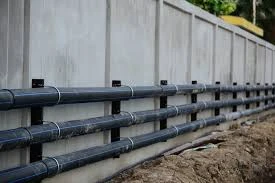កញ្ញា . 29, 2024 09:08 Back to list
Polyethylene Pipe Fittings Overview for Efficient Plumbing Solutions and Applications
Understanding Polyethylene Pipe Fittings Applications, Types, and Benefits
Polyethylene (PE) pipe fittings have become a staple in various industries due to their durability, flexibility, and resistance to corrosion and chemical damage. These fittings are essential components in plumbing, irrigation, municipal water distribution, and various industrial applications. This article explores the significance of polyethylene pipe fittings, the different types available, and their benefits.
What are Polyethylene Pipe Fittings?
Polyethylene pipe fittings are made from polyethylene, a thermoplastic that is commonly used in piping systems due to its lightweight and versatile nature. The fittings are designed to connect sections of pipe and facilitate the flow of liquids and gases. They are available in various shapes and sizes, depending on the requirements of the specific application.
Types of Polyethylene Pipe Fittings
There are several types of polyethylene pipe fittings, each serving different purposes
1. Elbows These fittings are used to change the direction of the piping system, typically at 45 or 90 degrees. They are crucial for navigating obstacles within a plumbing or drainage system.
2. Tees Tee fittings allow connections to be made in three directions. They are commonly used to branch off from the main line, providing flexibility in design and installation.
3. Reducers These fittings are designed to connect pipes of different diameters, ensuring a smooth transition and maintaining the flow of the medium being transported.
4. Couplings Couplings are simple fittings used to connect two sections of pipe securely. They are essential for creating longer runs of piping and are available in various sizes.
5. Flanges Flanged fittings enable easy connection and disconnection of pipes and facilitate repairs or changes to the system without extensive modifications.
polyethylene pipe fittings

6. Caps and Plugs These fittings are used to seal the ends of pipes, preventing leaks and contamination of the system. Caps completely cover the end of the pipe, while plugs may partially obstruct the flow.
Benefits of Polyethylene Pipe Fittings
Polyethylene pipe fittings offer numerous advantages, making them a popular choice across various sectors
1. Corrosion Resistance One of the main benefits of polyethylene fittings is their resistance to corrosion. Unlike metal fittings, PE pipe fittings do not rust or degrade when exposed to moisture, chemicals, or environmental conditions, leading to a longer lifespan for piping systems.
2. Flexibility and Lightweight Polyethylene is flexible and lightweight, allowing for easy installation and handling. This attribute is especially beneficial in large-scale projects where heavy, rigid materials can pose logistical challenges.
3. Cost-Effectiveness Although the initial investment in polyethylene pipe fittings might be comparable to other materials, their longevity and reduced maintenance requirements often result in lower overall costs in the long run.
4. Environmental Resistance Polyethylene fittings are resistant to a wide range of environmental factors, including UV rays and high temperatures. This resilience makes them suitable for outdoor applications where exposure to the elements is expected.
5. Ease of Installation The installation of polyethylene pipe fittings is generally straightforward, making it possible for both professionals and DIY enthusiasts to handle piping projects with relative ease. Specialized tools are often not necessary, which simplifies the process further.
Conclusion
Polyethylene pipe fittings play a critical role in a diverse range of applications, from residential plumbing to large-scale industrial systems. Their unique properties, such as corrosion resistance, flexibility, and lightweight nature, make them an ideal choice for modern piping solutions. Understanding the various types of fittings available and their benefits can help consumers and professionals make informed decisions that enhance efficiency and sustainability in their projects. As industries continue to evolve, polyethylene fittings will likely remain an essential component of piping infrastructure, supporting advancements in technology and design.
-
High-Quality PPR Pipes and Fittings Durable ERA PPR & PVC PPR Solutions
NewsJul.08,2025
-
Black HDPE Cutting Board - Durable, Non-Porous & Food Safe HDPE Plastic Cutting Board
NewsJul.08,2025
-
High-Quality CPVC Panel Durable HDPE & PVC Panels Supplier
NewsJul.08,2025
-
Double PE Welding Rod Supplier - High Strength, Durable & Versatile Welding Solutions
NewsJul.07,2025
-
High-Quality PVC-O Pipe Supplier Durable 75mm PVC Pipe & Connections Leading PVC Pipe Company
NewsJul.07,2025
-
HDPE Drainage Pipe Supplier – Durable & Corrosion-Resistant Solutions
NewsJul.06,2025

